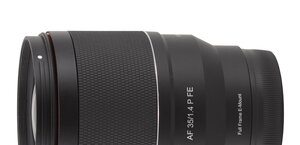Samyang 50 mm f/1.4 AS UMC
3. Build quality
However the next chart, comparing the Samyang to a bit older 1.4/50 class lenses, proves that the tested device firmly belongs to the new wave of optical instruments. It is noticeably bigger and heavier than the older construction, with far more complex optical design.
In the photo below the Samyang 50 mm f/1.4 AS UMC is positioned next to two other 50 mm devices: the Canon EF 1.4/50 USM and the Zeiss Makro-Planar 2/50.
Please Support UsIf you enjoy our reviews and articles, and you want us to continue our work please, support our website by donating through PayPal. The funds are going to be used for paying our editorial team, renting servers, and equipping our testing studio; only that way we will be able to continue providing you interesting content for free. |
- - - - - - - - - - - - - - - - - - - - - - - - - - - - - - - - - - - - - - - - - - - - - - - -
 |
The tested lens starts with a metal bayonet mount surrounding a rear element, 22 mm in diameter. That element is situated on the same level as the mount when the focus is set at infinity. When you pass to the minimum focal distance the element hides inside the casing about 1 cm deep, creating a crack through which you can glimpse the inner construction parts. As you see the lens can hardly be called sealed and dirt can access its interior without any problems.
 |
We tested the Canon mount version of the lens and in that case the Samyang didn’t feature any electrical contacts so it can’t communicate with the camera body. It means there will be no info concerning the aperture or focal length value in EXIF.
The first part of the proper lens body is a narrow, immobile ring behind which there is an aperture ring, 9 mm wide. It can be turned comfortably and is properly damped, working every 0.5 EV step (with the exception of the distance between f/1.4 and f/2.0 where the change amounts to 1 EV).
 |
The next part is a narrow, immobile ring. On it you can see a red stripe, the name and the parameters of the lens along with an inscription “Made in Korea” and depth of field markings ranging from f/22 to f/4.0. Further on you find a manual focus ring. It is very wide (40 mm) and partially covered by rubber ribs very pleasant to the touch; under it there is a distance scale expressed in feet and meters. The ring moves evenly and is well-damped; running through the whole scale takes a turn through 160 degrees.
Behind the focusing ring the lens turns smoothly into a hood mount. The front element of the lens is mobile and 50 mm in diameter, surrounded by a filter thread, 77 mm in diameter.
 |
When it comes to the inner construction you deal here with 9 elements positioned in 6 groups (including one aspherical and one hybrid element). Inside you can also find an aperture with eight blades which can be closed to f/22.0.
Buyers get both caps, a hood and a soft pouch in the box.
 |






